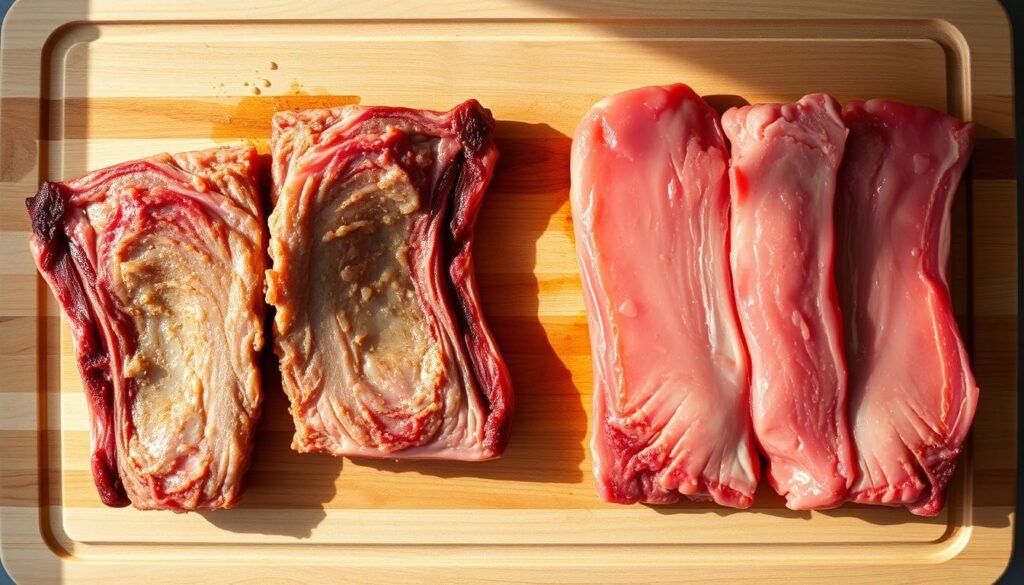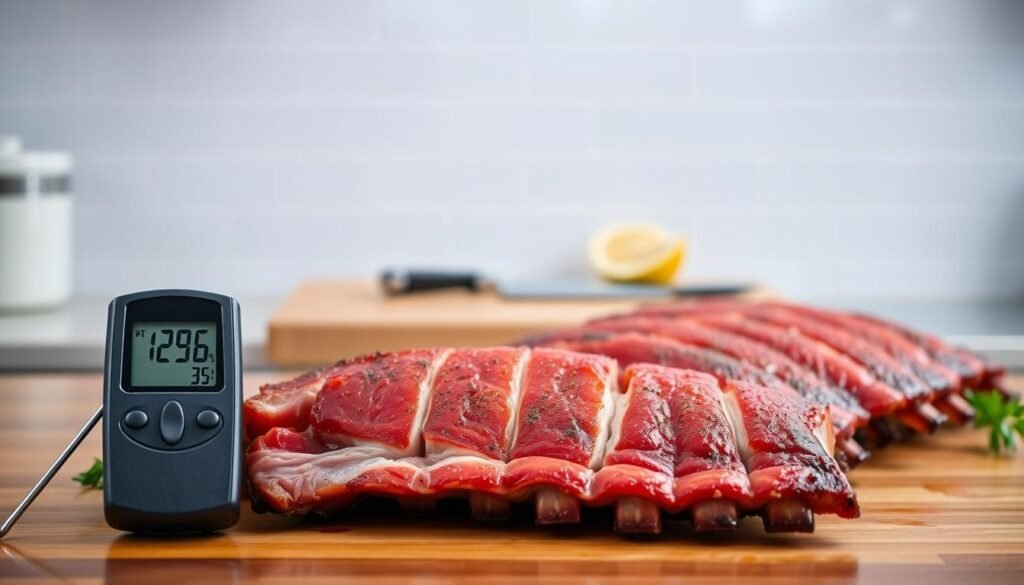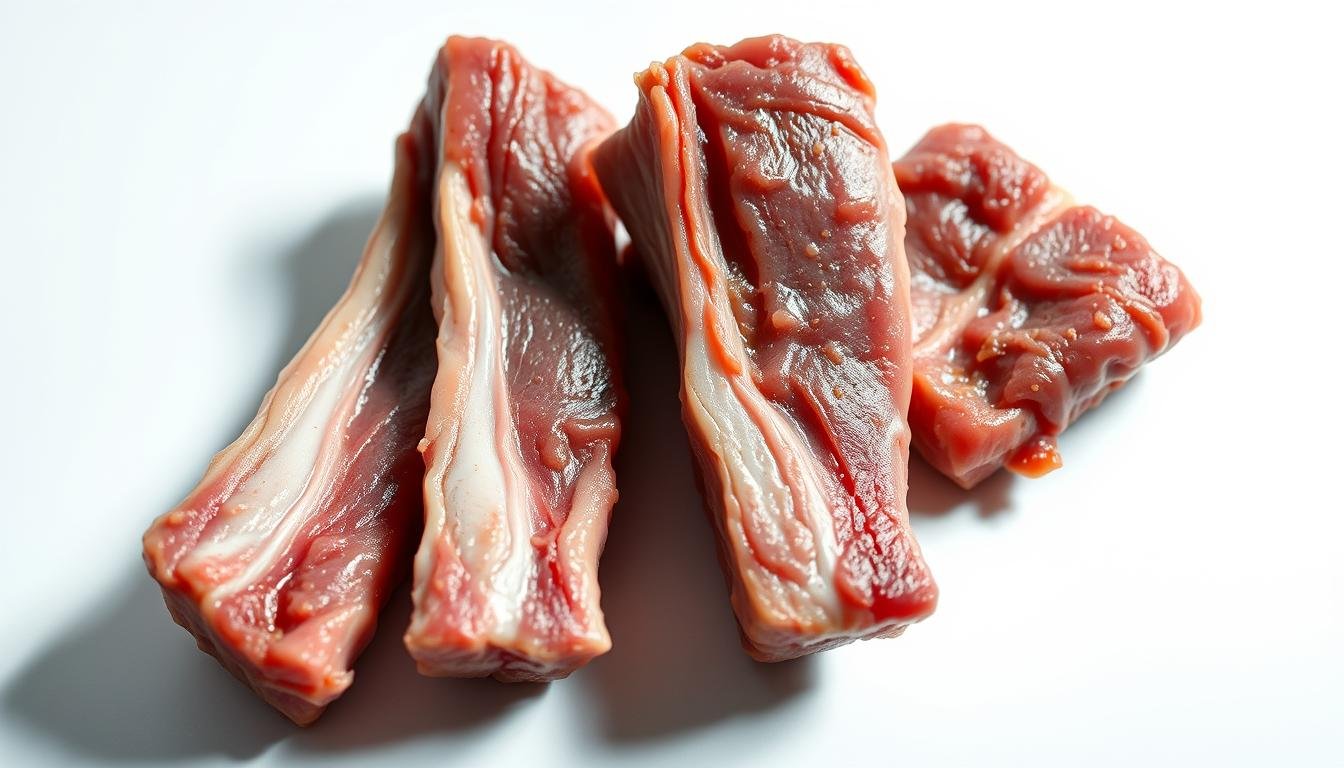Food safety is a top priority when it comes to consuming meat, especially when dealing with products like ribs. Identifying spoiled ribs is crucial to prevent foodborne illnesses.
According to food safety guidelines, spoiled meat can cause serious health issues. It’s essential to be aware of the signs of spoilage to avoid any potential risks.
Being able to identify bad ribs can save you from the discomfort and danger of food poisoning. In this article, we’ll guide you through the key indicators of spoiled ribs.
Key Takeaways
- Check for visible signs of spoilage on the ribs.
- Smell the ribs to detect any off odors.
- Verify the storage and handling practices.
- Be aware of the expiration date and storage conditions.
- Understand the risks associated with consuming spoiled meat.
The Risks of Consuming Spoiled Ribs
Understanding the risks of consuming spoiled ribs is essential for preventing food-related health hazards. Spoiled ribs can harbor harmful bacteria, making them a potential source of food poisoning.
Consuming spoiled meat can lead to severe health issues, including food poisoning. The symptoms can range from mild to severe and include nausea, vomiting, diarrhea, and abdominal cramps.
Health Hazards of Eating Bad Ribs
Eating bad ribs can result in foodborne illnesses caused by pathogens such as Salmonella and E. coli. These bacteria can cause severe health complications, particularly in vulnerable populations like the elderly, young children, and people with compromised immune systems.
Common health hazards include:
- Food poisoning
- Gastrointestinal issues
- Severe dehydration
Common Misconceptions About Meat Spoilage
Many people believe that spoiled meat can be made safe by cooking it at high temperatures. However, this is a common misconception. While cooking can kill some bacteria, certain toxins produced by bacteria are heat-stable and cannot be destroyed by cooking.
It’s also mistakenly believed that if meat looks and smells fine, it’s safe to eat. However, some harmful bacteria do not affect the appearance or odor of the meat.
Different Types of Ribs and Their Shelf Life
Different types of ribs have distinct shelf lives based on their cut and storage conditions. Understanding these differences is crucial for maintaining the quality and safety of the ribs.
Pork Ribs: Baby Back, Spare, and St. Louis Style
Pork ribs are a popular choice among barbecue enthusiasts. They come in various styles, including Baby Back Ribs, Spare Ribs, and St. Louis Style Ribs. Baby Back Ribs are leaner and have a shorter shelf life due to their lower fat content. Spare Ribs, on the other hand, have more fat, which can slightly extend their shelf life. St. Louis Style Ribs are essentially Spare Ribs with the breastbone and cartilage removed, making them more uniform.
The shelf life of pork ribs can vary, but generally, they last between 1 to 2 days in the refrigerator and up to 6 months when frozen.
Beef Ribs: Short Ribs and Back Ribs
Beef ribs, including Short Ribs and Back Ribs, have a different shelf life compared to pork ribs. Short Ribs are typically meatier and have a higher fat content, which can make them last a bit longer when stored properly. Back Ribs are leaner and more similar to pork ribs in terms of storage needs.
Beef ribs usually last 1 to 2 days in the refrigerator and can be stored in the freezer for up to 9 months.
Comparing Shelf Life Across Different Rib Types
When comparing the shelf life of different rib types, it’s essential to consider their fat content, storage conditions, and packaging. Generally, ribs with higher fat content tend to have a longer shelf life when frozen due to the protective effects of fat against freezer burn.
- Pork Ribs: 1-2 days refrigerated, up to 6 months frozen
- Beef Ribs: 1-2 days refrigerated, up to 9 months frozen
Proper storage and handling practices are crucial for maximizing the shelf life of ribs, regardless of the type.
How to Tell if Ribs Are Bad: Visual Indicators
Visual indicators play a crucial role in identifying whether your ribs have gone bad. When inspecting ribs, it’s essential to look beyond the surface level to determine their freshness and safety for consumption.
Fresh vs. Spoiled: Color Comparison
The color of ribs is a significant indicator of their freshness. Fresh ribs typically have a vibrant, rich color, whether they are pork or beef. For instance, fresh pork ribs should have a pinkish-red color, while beef ribs should have a deep red color. On the other hand, spoiled ribs may turn grayish, greenish, or develop uneven color patches. Any significant deviation from the expected color could be a sign of spoilage.
Identifying Mold and Slime Formation
Mold and slime formation are clear indicators that ribs have gone bad. Check the surface of the ribs for any visible mold, which can appear as white, green, or black patches. Additionally, if the ribs feel slimy to the touch, it’s a sign that bacteria have started to break down the meat. Mold and slime are not only signs of spoilage but can also be harmful if consumed.
Changes in Fat Appearance and Texture
The appearance and texture of the fat on ribs can also indicate their freshness. Fresh ribs typically have a smooth, even layer of fat. If the fat appears discolored, dried out, or has an unusual texture, it could be a sign that the ribs are no longer fresh. Paying attention to these details can help you make an informed decision about the safety of the ribs.
The Smell Test: Fresh vs. Spoiled Ribs
When it comes to checking the freshness of ribs, your nose can be a powerful tool. The smell test is a simple yet effective method to determine if your ribs have gone bad. Fresh ribs have a distinct aroma that is different from spoiled ones.

Normal Aromas of Fresh Ribs
Fresh ribs typically have a meat-like or slightly sweet aroma, depending on the type of meat and any marinades used. This natural scent is usually mild and not overpowering. If your ribs have a strong, unpleasant odor, it could be a sign of spoilage.
Warning Odors That Signal Spoilage
Spoiled ribs often emit a strong, pungent smell that is easily noticeable. This can include ammonia-like odors, a sour or acidic smell, or a generally putrid scent. If you notice any of these warning odors, it’s best to err on the side of caution and discard the ribs.
Distinguishing Between Natural Meat Odors and Spoilage
It’s essential to differentiate between the natural odors of fresh meat and the smells associated with spoilage. While fresh ribs may have a mild, meaty aroma, spoiled ribs will have a much stronger, more offensive smell. Trust your instincts; if the odor seems off or unpleasantly strong, it’s likely the ribs have spoiled.
Texture Comparison: Good Ribs vs. Bad Ribs
The texture of ribs can be a significant indicator of whether they are good to eat or have gone bad. Fresh ribs should have a firm texture, while spoiled ribs often become soft, mushy, or develop other undesirable textures.
The Feel of Fresh Ribs vs. Spoiled Ribs
Fresh ribs are typically firm to the touch. If you press on them gently, they should spring back quickly. On the other hand, spoiled ribs tend to feel soft or mushy. This change in texture is due to the breakdown of proteins and the growth of bacteria.
In some cases, spoiled ribs may also feel slimy or sticky. This sliminess is often a sign of bacterial growth, which can produce toxins harmful to consume.
The Touch Test: What to Feel For
When performing the touch test, look for ribs that are firm and have some give when pressed. If the ribs feel unusually soft or leave an indentation that doesn’t spring back, it’s likely they have gone bad.
Additionally, fresh ribs should not stick excessively to your fingers. If they do, it could be a sign of high bacterial activity.
Moisture Levels and Stickiness
Moisture levels can also indicate the freshness of ribs. While some moisture is normal, excessive wetness or stickiness can be a sign of spoilage. Fresh ribs should have a moderate level of moisture, but they shouldn’t feel wet or slimy to the touch.
Paying attention to these texture changes can help you determine if your ribs are still good to eat or if they should be discarded.
Expiration Dates and Storage Guidelines
To enjoy your ribs at their best, it’s essential to grasp the concepts of expiration dates and storage guidelines. Proper storage and understanding packaging dates are crucial for maintaining the freshness of meat products.
Understanding Packaging Dates and Labels
Packaging dates on ribs can be confusing, with terms like “Sell By,” “Use By,” and “Best If Used By.” The “Sell By” date is intended for retailers, indicating how long they should display the product. The “Use By” date is the last date recommended for the use of the product at peak quality. “Best If Used By” suggests the last date for optimal quality.
It’s crucial to understand that these dates are not safety dates but rather quality indicators. Consumers should use their judgment, considering factors like storage conditions and packaging integrity.
Proper Storage Temperatures: Refrigerated vs. Frozen
Storage temperature plays a significant role in maintaining the quality and safety of ribs. Refrigerated ribs should be stored at a temperature below 40°F (4°C), while frozen ribs should be kept at 0°F (-18°C) or below.
“The key to keeping ribs fresh is consistent refrigeration at the right temperature.”
Refrigeration slows down bacterial growth, but it’s not a foolproof method. Freezing, on the other hand, halts bacterial growth, making it a more reliable long-term storage solution.
Shelf Life Comparison Chart: Fresh vs. Frozen Ribs
Understanding the shelf life of fresh versus frozen ribs can help in planning meals and storage. Here’s a comparison chart:
| Type of Ribs | Storage Method | Shelf Life |
|---|---|---|
| Fresh Ribs | Refrigerated | 3-5 days |
| Fresh Ribs | Vacuum-Sealed and Refrigerated | 7-10 days |
| Frozen Ribs | Frozen | 6-9 months |
In conclusion, understanding expiration dates and following proper storage guidelines are vital for maintaining the quality and safety of ribs. By knowing how to store ribs correctly and being aware of their shelf life, consumers can enjoy their ribs at their best.
Packaging Types and Spoilage Signs
The way ribs are packaged can significantly influence their shelf life and signs of spoilage. Different packaging methods can either preserve the freshness of ribs or potentially lead to quicker deterioration if not done correctly.
Vacuum-Sealed Ribs: Normal vs. Concerning Signs
Vacuum-sealed ribs are packaged by removing the air from the package, which helps in preserving the meat. Normal signs of fresh vacuum-sealed ribs include a tight package with no air leaks and a fresh meat color. Concerning signs include bloating of the package, which could indicate bacterial growth, or a sour smell when opening.
Key indicators to check:
- Package integrity
- Meat color
- Presence of juices
Store-Wrapped Ribs: What to Look For
Store-wrapped ribs are typically packaged in a tray wrapped with plastic wrap or in a similar format. When checking store-wrapped ribs, look for the freshness of the meat, the presence of any visible mold, and the condition of the wrapping. Fresh ribs should have a good meat color, and the wrapping should be tight without any signs of leakage.
Signs of spoilage include:
- Visible mold
- Slimy texture
- Off or sour smell
Pre-Marinated Ribs: Special Considerations
Pre-marinated ribs have been treated with a marinade that can affect their spoilage signs. The marinade can sometimes mask the natural smell of the meat, making it harder to detect spoilage. Check the expiration date, the condition of the packaging, and the appearance of the ribs. Be cautious of ribs that have an off smell or appearance, even if they are within the expiration date.
| Packaging Type | Signs of Freshness | Signs of Spoilage |
|---|---|---|
| Vacuum-Sealed | Tight package, fresh color | Bloating, sour smell |
| Store-Wrapped | Good meat color, tight wrapping | Visible mold, slimy texture |
| Pre-Marinated | Within expiration date, good appearance | Off smell, bad appearance |
Preventing Rib Spoilage: Best Practices
Preventing rib spoilage starts with understanding the best practices for handling and storing ribs. Proper handling and storage are crucial to extending the shelf life of meat products.
Proper Handling and Storage Techniques
To keep ribs fresh, it’s essential to store them at the correct temperature. Refrigerated ribs should be kept at a temperature below 40°F (4°C). When storing ribs in the refrigerator, place them in a covered container or wrap them tightly in plastic wrap or aluminum foil to prevent moisture from accumulating.
Safe storage practices also involve keeping ribs away from strong-smelling foods, as ribs can absorb odors easily. Use a shelf or a designated area for meat to prevent cross-contamination.
Freezing Methods to Extend Shelf Life
For longer storage, freezing is an effective method. To freeze ribs, wrap them tightly in freezer-safe packaging or place them in airtight containers. Label the packaging with the date and contents.
When you’re ready to use the frozen ribs, thaw them in the refrigerator or thaw them quickly by submerging the packaging in cold water. Proper thawing is crucial to prevent bacterial growth.

Conclusion
Understanding how to tell if ribs are bad is crucial for preventing foodborne illnesses. Throughout this article, we’ve explored various signs of spoiled ribs, including visual indicators, unpleasant odors, and changes in texture.
By being aware of these signs and following proper storage and handling guidelines, you can ensure the ribs you consume are safe and fresh. This knowledge is essential for maintaining food safety in your kitchen.
Remember, when it comes to consuming ribs or any other meat, it’s always better to err on the side of caution. If you’re unsure whether your ribs are still good, it’s best to discard them to avoid potential health risks.
By applying the tips and guidelines outlined in this article, you can enjoy your ribs while minimizing the risk of foodborne illness. Stay informed, and stay safe.
